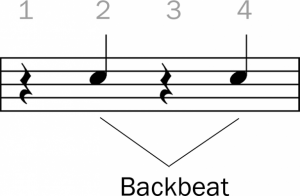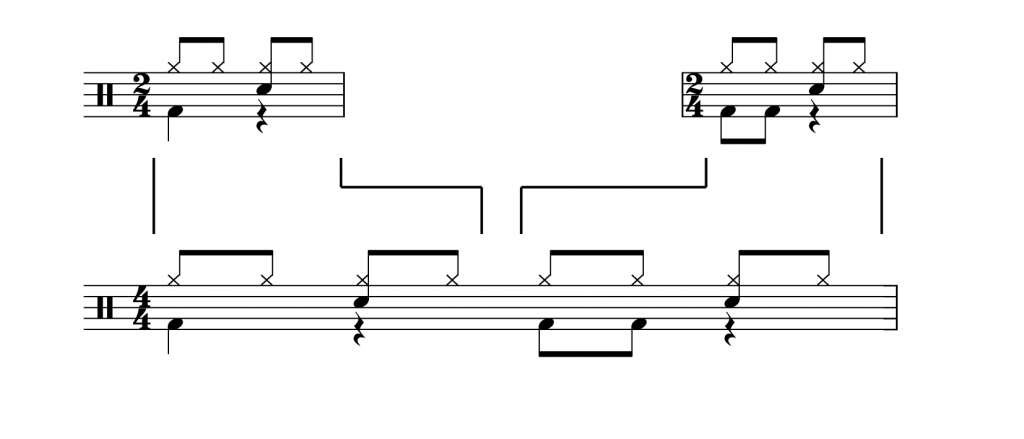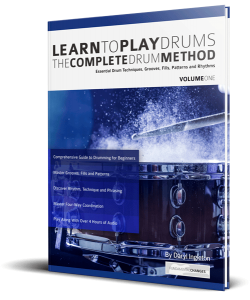Grooves – Backbeat on Drums with 1/8th Note Bass Drum
Drum Grooves are repeated phrases that secures the rhythm, tempo and time. Because of the drum kits rhythmic properties, it is perfect for this role.
A drum groove secures the rhythm, time and tempo by playing on the rhythmic subdivision of the music and accentuating the time signature and rhythmical accents.
Grooves are the backbone and an integral part of drum playing. Without grooves, the line between noise and orchestrated sound would become ambiguous. Drum grooves secure musicians and leads them musically. Grooves can be simple and unchanging, or continuously developing and never repeating. A groove is a drummer’s most used tool.
One of the key parts of a drum groove is the Backbeat
The Backbeat
The term Backbeat refers to the accented notes that are typically on the 2nd and 4th beat in a bar. The Backbeat can vary depending on the time signature; however, it is almost universally on the2nd and 4th beat. These accents are typically on the snare, but can be on any part of the kit.
The Backbeat and the drum kit go hand in hand, as they both came into fruition around the same time. In the early 1900’s the drum kit had started to develop, and by the late 1930’s it had become the Modern Drum Kit. At the same time, you see the growth of Jazz, Country and Gospel. These genres, very quickly, started to adopt the drum kit. The drummers that were playing started to mimic these genres strong rhythmic accents on the 2nd and 4th beat (usually on hand claps or other percussive instruments).
As new styles arose, and the drumkit gained in popularity, the concept of playing on the2nd and 4th beat became very wide spread. In the 1950’s you see the birth of Rock’n’roll. The drum kit was an integral part of this genre and so was the Backbeat. From this moment onwards the Backbeat truly became ingrained into popular music and has only increased in popularity.

Playing grooves is at the heart of drumming. The best place to begin is to learn how to play 1/8th note bass drum patterns whilst playing a Hi-Hat pattern with a backbeat on a snare. To construct and play 1/8th noted based bass drum patterns you only need to understand the sixteen different 1/8th note bass drum rhythms that fit inside two Beats.
Below you will see these sixteen patterns. These exercises are written in a 2/4 time signature. A 2/4 bar has two beats in a bar and each beat has the duration of a 1/4 note. Simply put, a 2/4 bar has half the length of a 4/4 bar.
The sixteen patterns below are the basis of all backbeat grooves with 1/8th note bass drum.With these sixteen bars of 2/4 you can create 256 different combinations in a bar of 4/4. So learn these patterns so you can start constructing your on grooves.
These exercises have 1/8th note based bass drum patterns, constant 1/8th note Hi-Hats and a backbeat on the snare. Play each exercise until you are comfortable with it.
Tips
- Make sure the backbeat is strong.
- Ensure the note unisons are together
- Pay attention to the repeat signs.








Backbeat on Drums: Constructing your own grooves
Now that you have memorised and mastered backbeat grooves with 1/8th note bass drum in 2/4. It is now time to start creating your own grooves in 4/4. To do this all you have to do is choose two of the previous exercises and combine them to create a groove in 4/4. The image below demonstrates this concept.

You now have everything you need to start creating your own backbeat grooves with 1/8th note bass drum. Start creating all the grooves you can, learn what works for you and learn what you like. And don’t forget to have fun with it.
This lesson has been taken from my new drum book, Learn To Play Drums. It is a comprehensive guide to playing the drums for beginners, taking you through the fundamental drumming techniques, knowledge, patterns and vocabulary.
“The artists you work with, and the quality of your work speaks for itself.”
Tommy Emmanuel
© Copyright Fundamental Changes Ltd 2024
No.6 The Pound, Ampney Crucis, England, GL7 5SA

